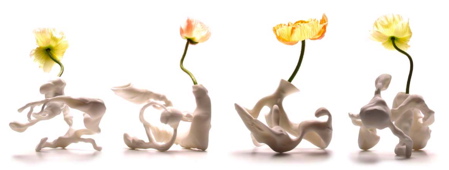Twenty-First Century icons: dezeen is on holiday this week so each day we’re posting a chapter from dezeen editor Marcus Fairs’ book, Twenty-First Century Design.
Airborne Snotty Vases
Date 2001
Designer Marcel Wanders
Material Polyamide
Manufacturer Cappellini, Italy
Designers have always drawn on natural forms as inspiration for their products but this project by Marcel Wanders takes it to a new extreme.
Using the latest digital-scanning technology it captures the form of mucus particles emitted during a sneeze and turns them into vases.

Called Airborne Snotty, the series consists of five vases named after five different diseases of the nasal cavity: ozaena (fetid discharge), pollinosis (hay fever), coryza (runny nose), influenza and sinusitis.
The project began by digitally recording a human sneeze with a three-dimensional scanner. The scanner, which resembles a magnifying glass without a lens, took a snapshot of the rain of microscopic mucus particles as they flew through the air. They were then transferred to a computer.
From the thousands of particles scanned, the design team then selected five individual particles that would form the basis of the vases.
These were enlarged from their original miniscule scale to an average size of 15 cm by 15 cm by 15 cm (6 in by 6 in by 6 in) and digitally edited to create hollows in which flowers could be placed to allow them to function as vases.
The finished computer files were sent to a rapid prototyping machine, which printed the vases in polyamide.
The five vases that were created as a result of this process were each named after one of the nasal diseases. They went on sale in 2001 and a complete set was purchased by Amsterdam’s Stedelijk Museum.
With Airborne Snotty, Wanders is one of a number of designers exploring the potential of high-tech scanning techniques.
Others include architect Frank Gehry, who uses three-dimensional scanners to digitize the sculptural cardboard and paper models he makes in his studio, while Swedish design outfit Front have produced a range of furniture formed by sketching chairs, tables and lamps in the air with a hand-held motion capture scanner (see page 149).





又没中文~